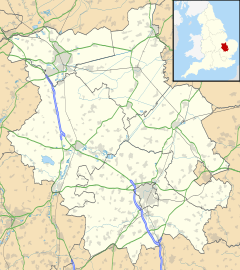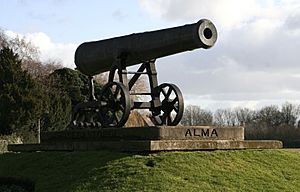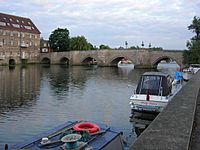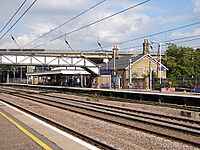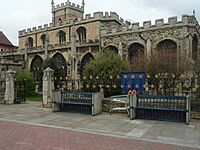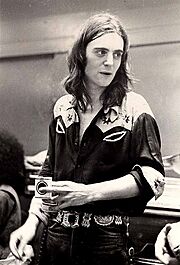Huntingdon facts for kids
Quick facts for kids Huntingdon |
|
|---|---|
| Market town | |
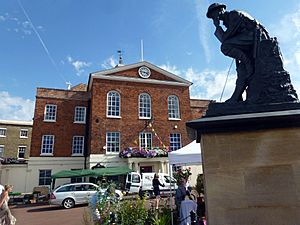 Huntingdon Town Hall and The Thinking Soldier War Memorial |
|
| Population | 25,428 (2021 Census) |
| OS grid reference | TL245725 |
| District | |
| Shire county | |
| Region | |
| Country | England |
| Sovereign state | United Kingdom |
| Post town | HUNTINGDON |
| Postcode district | PE28, PE29 |
| Dialling code | 01480 |
| Police | Cambridgeshire |
| Fire | Cambridgeshire |
| Ambulance | East of England |
| EU Parliament | East of England |
| UK Parliament |
|
Huntingdon is a busy market town in Cambridgeshire, England. It's located in the area called Huntingdonshire. The town got its special permission to hold markets, known as a town charter, from King John way back in 1205. For a long time, it was the main town, or county town, of the historic county of Huntingdonshire.
Many famous people have connections to Huntingdon. Oliver Cromwell, a very important figure in English history, was born here in 1599. He later became one of the town's Members of Parliament (MPs) in 1628. Also, John Major, who was the Prime Minister from 1990 to 1997, served as Huntingdon's MP from 1979 until he retired in 2001.
Contents
Huntingdon's Past
Huntingdon has a long and interesting history!
Ancient Discoveries
In 2018, a huge collection of ancient Roman coins was found in Huntingdon. This "Muddy Hoard" had 9,724 coins from the year 274 AD. It's the biggest treasure of its kind ever found in Cambridgeshire!
How Huntingdon Started
Huntingdon was first settled by the Anglo-Saxons and Danes. The town's name first appeared in old records in 921 as Huntandun. Later, in the Domesday Book of 1086, it was called Huntedun. The name likely means "The huntsman's hill" or perhaps "Hunta's hill."
For a while, Huntingdon was a base for Danish raids. But in 917, the Danes moved away. The town grew because it was a good place to cross the River Great Ouse. It became a successful market town and, in the 1700s and 1800s, a major stop for coaching (where horse-drawn coaches would stop for rest and to change horses). The famous George Hotel was a key stop.
The Old Bridge and Castle
Huntingdon has a beautiful, well-preserved medieval bridge. This bridge used to be the main way to cross the river on the old Ermine Street road. It was the only crossing point to Godmanchester until 1975, when a new bypass road was built.
To protect its valuable trading spot, Huntingdon Castle was built. Today, only the earth mounds of the castle remain. This site is very old and important, and it even has a beacon that was lit to celebrate 400 years since the Spanish Armada.
In 1746, a special type of elm tree, called the Huntingdon Elm, was created near the town.
You can find old documents about Huntingdon's history, including the 1205 town charter, at the County Record Office in Huntingdon.
In 1981, a small tornado hit parts of Huntingdon, including the town centre, causing some damage.
Near the railway station, there's a replica cannon. The original cannon was from the Crimean War but was melted down to help with the war effort during the Second World War.
The George Hotel
The George Hotel is a very old and famous building in Huntingdon. It was named after Saint George in 1574. About 25 years later, Henry Cromwell, who was the grandfather of Oliver Cromwell, bought it.
King Charles I even stayed at the George Hotel in 1645. Later, the famous highwayman Dick Turpin is said to have visited when it was a busy stop on the Great North Road.
A theatre was built behind the hotel around 1799. For many years, the hotel's courtyard and balcony were used for Shakespeare plays by a group called the Shakespeare at the George Trust. Sadly, in 2024, the hotel decided to stop these performances after 65 years.
Huntingdon's Location and Nature
Where is Huntingdon?
Huntingdon is on the north side of the River Great Ouse. It's right across from Godmanchester. Nearby towns include St Ives to the east and Brampton to the west. Huntingdon also includes areas like Hartford, Oxmoor, Stukeley Meadows, and Hinchingbrooke.
Portholme Meadow
Between Godmanchester, Huntingdon, and Brampton, you'll find Portholme Meadow. This is England's largest meadow, covering about 257 acres! It's home to many rare types of grass, flowers, and even dragonflies. It's the only place in Britain where the marsh dandelion grows. The meadow also helps prevent floods by holding extra river water. In the past, it was used for horse races and even as an early aviation centre.
Local Businesses
Huntingdon has many local businesses, including the Huntingdon Racecourse. The Hinchingbrooke Business Park also has many offices and warehouses.
Weather in Huntingdon
Huntingdon has a mild, maritime climate, which means it doesn't usually have extreme temperatures. Rain is spread fairly evenly throughout the year.
The hottest temperature ever recorded nearby was 35.4°C in August 1990. On average, the warmest day of the year is around 29.7°C.
It typically freezes on about 43 nights a year. The coldest temperature ever recorded was -16.1°C in January 1982.
Huntingdon is one of the driest areas in the UK, with less than 550 mm of rain each year. On average, there are about 103 days a year with at least 1 mm of rain.
| Climate data for Monks Wood (1991–2020) | |||||||||||||
|---|---|---|---|---|---|---|---|---|---|---|---|---|---|
| Month | Jan | Feb | Mar | Apr | May | Jun | Jul | Aug | Sep | Oct | Nov | Dec | Year |
| Mean daily maximum °C (°F) | 7.6 (45.7) |
8.4 (47.1) |
11.1 (52.0) |
14.1 (57.4) |
17.2 (63.0) |
20.0 (68.0) |
22.6 (72.7) |
22.5 (72.5) |
19.5 (67.1) |
15.2 (59.4) |
10.7 (51.3) |
7.8 (46.0) |
14.8 (58.6) |
| Mean daily minimum °C (°F) | 1.4 (34.5) |
1.4 (34.5) |
2.6 (36.7) |
4.2 (39.6) |
6.8 (44.2) |
9.9 (49.8) |
11.9 (53.4) |
12.0 (53.6) |
10.0 (50.0) |
7.4 (45.3) |
4.2 (39.6) |
1.8 (35.2) |
6.2 (43.2) |
| Average rainfall mm (inches) | 48.7 (1.92) |
37.4 (1.47) |
37.8 (1.49) |
42.7 (1.68) |
45.5 (1.79) |
52.3 (2.06) |
55.9 (2.20) |
56.0 (2.20) |
52.6 (2.07) |
63.2 (2.49) |
57.0 (2.24) |
53.3 (2.10) |
602.3 (23.71) |
| Average rainy days (≥ 1 mm) | 10.5 | 9.2 | 8.7 | 8.6 | 8.1 | 8.7 | 8.2 | 8.8 | 8.5 | 10.0 | 11.1 | 10.5 | 111.1 |
| Mean monthly sunshine hours | 57.4 | 80.6 | 118.8 | 159.3 | 191.8 | 184.5 | 195.0 | 184.0 | 147.3 | 111.9 | 66.9 | 57.7 | 1,555.2 |
| Source: Met Office | |||||||||||||
People of Huntingdon
Population Over Time
Between 1801 and 1901, Huntingdon was made up of four smaller areas. The number of people living in these areas was counted every ten years. The population grew from 2,368 in 1801 to 4,735 in 1891.
| Parish | 1911 | 1921 | 1931 | 1951 | 1961 | 1971 | 1981 | 1991 | 2001 | 2011 |
|---|---|---|---|---|---|---|---|---|---|---|
| Huntingdon | 4,464 | 4,644 | 4,570 | 5,282 | 14,648 | 15,451 | 20,099 | 23,732 | ||
| All population census figures are taken from the report Historic Census figures Cambridgeshire to 2011 by Cambridgeshire Insight. For the censuses of 1961 and 1971, Huntingdon was combined with Godmanchester. | ||||||||||
In 2011, the town covered about 2,765 acres. There were about 5,493 people per square mile.
Culture and Community
The old Literary and Scientific Institute building is now called Commemoration Hall.
Near Huntingdon, there are two active RAF (Royal Air Force) bases: RAF Wyton and RAF Alconbury. RAF Wyton is now a facility for military equipment, and RAF Alconbury is used by the United States Air Force.
Part of an old hospital building in the market place became Huntingdon Grammar School. Both Oliver Cromwell and the famous diarist Samuel Pepys went to school here. Today, the building is the Cromwell Museum, which is run by the local council.
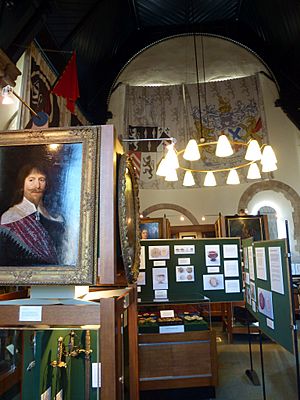
Local Legends
Hinchingbrooke House, which used to be a convent, is said to be haunted. The bridge over the Alconbury Brook, called Nun's Bridge, is also said to be haunted by a nun who once lived at the convent. People say she is often seen with another ghost that looks like a nurse. The story goes that the nun had a secret monk lover, and they were both murdered.
Media
You can get local news and TV shows from BBC East and ITV Anglia.
For radio, you can listen to BBC Radio Cambridgeshire, Heart East, Greatest Hits Radio East, Star Radio, and HCR FM, which is a local community radio station.
The Hunts Post is the town's weekly local newspaper.
Education
Huntingdon has several primary schools, including Hartford Junior School, Huntingdon Primary School, Thongsley Fields Primary School, St John's Primary School, Stukeley Meadows Primary School, and Cromwell Academy Primary School. Spring Common School is a special-needs school.
For older students, the secondary schools are St Peter's School and Hinchingbrooke School. For further education after secondary school, there's Huntingdonshire Regional College, Hinchingbrooke School sixth-form college, and St Peter's sixth form.
Transport
Trains
Huntingdon railway station is on the East Coast Main Line, a major train route. Trains here are run by Govia Thameslink Railway.
You can take Great Northern services between Peterborough and London Kings Cross station, which takes just over an hour to reach London. Thameslink services go between Peterborough and Horsham, passing through St Pancras and Blackfriars in London.
Buses
Bus services in Huntingdon are mainly run by Stagecoach East and Whippet. These buses serve the town, including Hinchingbrooke Hospital, and connect Huntingdon to other places like Peterborough, St Neots, Ramsey, St Ives, and Cambridge.
Airports
Luton and Stansted airports are both within 40 miles of Huntingdon.
Places of Worship
Huntingdon has four Church of England churches: All Saints' (next to the Market Square), St Mary's (opposite Pathfinder House), St Barnabas (on the Oxmoor estate), and All Saints', Hartford.
The Huntingdon Methodist Church is on the High Street. Medway Christian Fellowship is located on Medway Road.
Sports
The main football club in Huntingdon is Huntingdon Town, which plays in the United Counties League. Another team, Huntingdon United RGE, plays in the Cambridgeshire League.
Famous People from Huntingdon
Many interesting people have come from Huntingdon! Here are a few:
Arts and Entertainment
- Henry Compton (1805–1877), an actor, was born in Huntingdon.
- George Mackley (1900–1983), a wood engraver, was born in Huntingdon.
- Terry Reid, (born 1949), a rock singer and guitarist, was born in Huntingdon.
- The Charlottes (formed 1988), an indie rock band, started in Huntingdon.
- Ceara O'Neill (born 1990), an actor and musician, was born in Huntingdon.
- Himesh Patel (born 1990), an actor, was born in Huntingdon.
Writers and Historians
- Henry of Huntingdon (around 1088–1157), a historian and Archdeacon of Huntingdon.
- Samuel Pepys (1633–1703), a famous diarist, went to Huntingdon Grammar School around 1644.
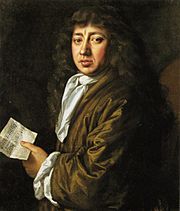
- Basil Montagu (1770–1851), a lawyer, writer, and helper of others.
- Robert Carruthers (1799–1878), a local historian and journalist.
Religion
- Christina of Markyate (around 1096–98 – around 1155), a religious woman, was born in Huntingdon.
- John Swanel Inskip (1816–1884), an American minister, was born in Huntingdon.
Science and Engineering
- Michael Foster (1836–1907), a physiologist and professor, was born in Huntingdon.
- Robert William Edis (1839–1927), an architect and writer, was born in Huntingdon and went to Huntingdon Grammar School.
- Walter Samuel Millard (1864–1952), a naturalist and conservationist, was born in Huntingdon.
Sports Stars
- Walter Yarnold (1893–1978), a first-class cricketer, was born in Huntingdon.
- Josh Gifford, (1941–2012), a horse racing jockey and trainer, was born in Huntingdon.
- Oliver Gavin (born 1972), a racing car driver, was born in Huntingdon.
- Charlotte Edwards (born 1979), an international women's cricketer, was born in Huntingdon.
- Darren Bent (born 1984), a footballer, grew up in Huntingdon.
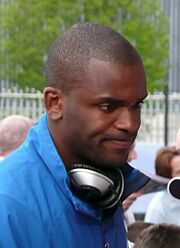
- Harriet Lee (born 1991), a Paralympic swimmer, was born in Huntingdon.
- James Sykes (born 1992), a first-class cricketer, was born in Huntingdon.
- James Kettleborough (born 1992), a first-class cricketer, was born in Huntingdon.
- Alex Martin (born 1992), a first-class cricketer, was born in Huntingdon.
- Todd Kane (born 1993), a footballer, was born in Huntingdon.
- George Furbank (born 1996), an England international rugby union player, was born in Huntingdon.
Huntingdon's International Friends
Twin Towns
Huntingdon has special friendships with towns in other countries, called "twin towns":
 Salon de Provence, France
Salon de Provence, France Szentendre, Hungary
Szentendre, Hungary Wertheim am Main, Germany
Wertheim am Main, Germany Gubbio, Italy
Gubbio, Italy
Freedom of the Town
The "Freedom of the Town" is a special honour given to people or military groups who have done great things for Huntingdon.
Individuals Honoured
- Gordon Peacock: 7 May 2022
- Derek Bristow: 7 May 2022
Military Units Honoured
- RAF Wyton: 17 September 1955
- RAF Brampton: 1995
- The Royal Anglian Regiment: 21 January 2010
- The Princess of Wales's Royal Regiment: 23 November 2017
- The 501st Combat Support Wing, USAF: 21 September 2018
See also
 In Spanish: Huntingdon para niños
In Spanish: Huntingdon para niños


